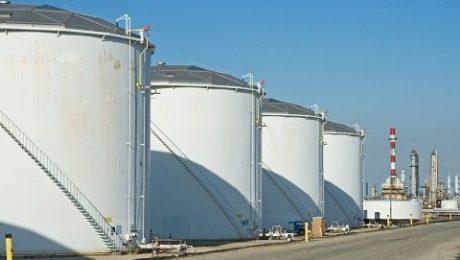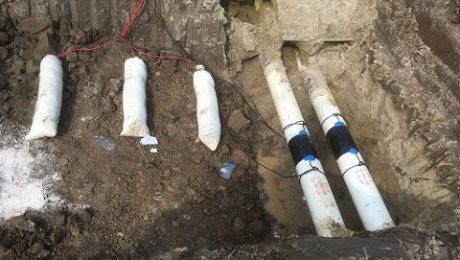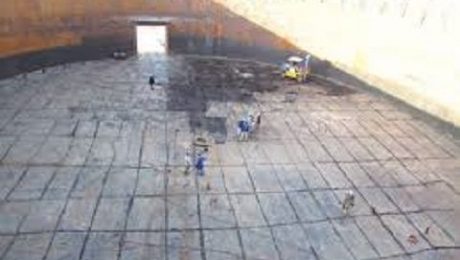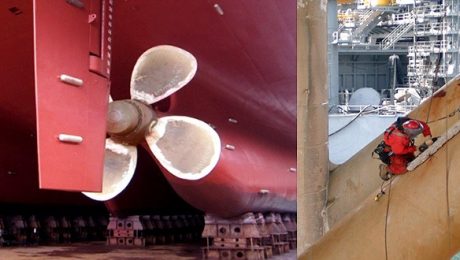Cathodic protection of aboveground storage tanks
Protection of aboveground storage tanks against corrosion
Both sacrificial anodes and impressed current system are used for cathodic protection of aboveground storage tanks. In this method, the protection of the inner surface of the tank is done by the method of sacrificial anodes and the protection of the outer surface of the tank floor is done by ribbon MMO anodes. Because the tank has large dimensions and therefore high weight, to support the weight of the tank, ribbon anodes with a flat cross section are used. Also, flat anode will lead to better flow in the tank floor. Before placing the bottom and body of the tank in the desired location, first the anodes are installed in the correct way, then a special layer of sand is poured on it and finally the bottom of the tank is placed on the sand.
Cathodic protection of the tank floor
The impressed current cathodic protection system is placed in the bottom of the tank in such a way that first the ribbon MMO anodes are laid in the form of horizontal strips in the bottom of the tank and in order to connect the anodes to the rectifier, the conductor bar which are titanium strips without cover, are used perpendicular to ribbon anodes. The connection of titanium bar to ribbon anodes is done by spot welding. The negative phase of the rectifier is connected to several points of the tank body. The positive phase of the rectifier is connected to a junction box and then through it, titanium bars is attached to the anode. The job of titanium is to deliver current to the anode. These connections are well done in different places so that no interruptions occur. Also, a number of permanent reference electrodes are placed on the bottom of the tank so that the potential of different parts of the tank can be measured.
![]()
In the past, other methods were used to cathodically protect the tank around it, such as drilling wells and placing anodes around the tank. But these methods did not bring the flow evenly to the bottom of the tank.
Cathodic protection inside the tank
The ribbon anodes inside the soil only protect the outer surface of the tank floor from corrosion. Because there is a different electrolyte inside the tank, such as water or crude oil, other anodes must be used to protect the inside of the tank. Sacrificial anodes, and in some cases impressed current anodes, are commonly used to protect the inner surface of the tank. Inside the crude oil tanks, only the sacrificial zinc anode is used.
- Published in Articles, Educational, Scientific
Types of backfill in cathodic protection system
Types of backfill
The type of backfill used in the cathodic protection system in ground substrates depends on the type of cathodic protection system used. Due to the fact that the cathodic protection system exists in two types of sacrificial anode systems and impressed current anode systems, so two types of backfill materials are also used.
Sacrificial anode systems
The sacrificial zinc and magnesium anodes used to cathodic protection of structures buried in the soil are sometimes packed in a linen bag with a backing material. These materials reduce the local corrosion of the anode by preventing the anode from coming into direct contact with the soil. It also prevents the anode from becoming passive by reacting with salts in the soil. The backfill used improves the performance of the anode by creating a low-resistance environment around the anode. These materials are generally a combination of three types of gypsum gypsum, bentonite and sodium sulfate, and the percentage of their compounds depends on the environment used.
The following table shows the types of backfills according to the IPS-M-TP 750 standard:

Impressed current system
Impressed current anodes for cathodic protection of underground structures are usually surrounded by a carbon backfill. The purpose of using this support is:
- By reducing the resistance of the environment around the anode, it leads to an increase in the amount of current produced by the anode.
- As the anode level increases, the amount of current increases.
- Reduce anode consumption rate and thus increase anode lifetime.
Carbon backfill according to IPS-M-TP 750 standard is available in three types of 80% metallurgical coke, 90% petroleum coke and 95% special petroleum coke.
The chemical composition of these three types of backfill is specified in the table below:

Coal coke is generally used in shallow horizontal substrates. Petroleum coke or special petroleum is used for deep wells.
- Published in Articles, Educational, Scientific
Mixed metal oxide anode (MMO) and its applications
What is a mixed metal oxide anode?
Mixed metal oxide anodes are made of a titanium substrate coated with mixed metal oxides. The coating is applied by several thermal processes on the titanium base to create a chemical resistant layer. Due to the inherent stability of titanium, this coating achieves the best performance of the anode by strengthening the conductivity of the anode.
MMO anodes have advantages such as very low consumption rate and high current capacity. Low anode consumption rate causes the anode dimensions to remain almost constant over the life of the anode. Therefore, these anodes are widely used in impressed current systems for land and marine structures.
MMO anode applications
MMO anode is used in cathodic protection system in different types of tubes, ribbons, meshes, wires and plates. These anodes can be used effectively in all environments such as soil, fresh water and saline water. Depending on the environment in which the anode is located, two types of coatings are considered for the anode. Iridium-tantalum coating is used in soil and fresh water and iridium-tantalium-ruthenium coating is used in saline water. The anode current capacity in soil, coke or fresh water is 100Amps \ m2 and in saline water is 600Amps \ m2.

various type of MMO anodes
Types of MMO anodes
- Tubular Anode
Tubular anode is the most common type of MMO anode used in cathodic protection systems. The titanium of this anode is manufactured according to ASTM B338 Grade1 standard. Tubular anodes are usually used as strings in deep wells.
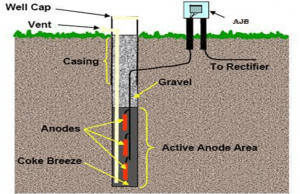
cathodic protection of deep wells by tubular mmo anodes
- Ribbon Anode
The titanium base of these anodes is manufactured according to ASTM B265 Grade1 standard and uses iridium / tantalum mixed metal oxide coating. This type of anode is used to protect the external bases of aboveground storage tanks. Ribbon anodes are suitable for connection to titanium conductors by spot welding to create a network under the tank that also provides a uniform distribution of current.
- Mesh Anode
Mesh MMO anodes are used in cathodic protection systems of reinforced concrete structures. Titanium mesh anode base like ribbon anode is produced according to ASTM B265 Grade1 standard and the anode quality is checked according to NACE TM0294 standard.
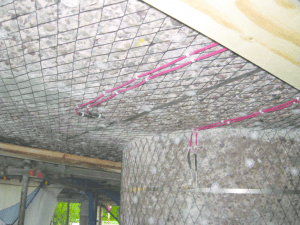
- Wire Anode
Titanium wire anode is an ideal cathodic protection product for protecting the bottom of tanks, submarines and pipelines. This type of anode is made of high grade titanium with a mixed metal oxide coating and has a lifetime of more than 50 years.
- Plate Anode
These types of anodes are designed as rectangular or circular plates for use on ships and vessels.
- Published in Articles, Educational, Scientific
Cathodic protection of pipelines
The role of cathodic protection of pipelines in the oil and gas industry
One of the main and very costly problems in large industries such as gas, oil, petrochemical, shipping, etc., is the corrosion of metal structures.
In the oil and gas industry, carbon steel pipelines are used to transport hydrocarbons from jackets to production platforms and storage tanks, and enter refineries through pipelines. Carbon steel pipelines are the safest and least expensive way to transport large volumes of hydrocarbons over long distances.
Fuel and water transmission pipelines and other structures buried in soil or submerged in water, due to their metallurgical conditions, are in a state of corrosion and after a while, the performance of the structure is disrupted.
Corrosion in the oil and gas industry dramatically increases the overhead costs of plumbing operations due to the replacement of worn equipment and damage to adjacent equipment. Therefore, it is necessary to use a proper protection system to prevent corrosion.
Corrosion control mechanism in cathodic protection of pipelines
Corrosion control mechanisms in oil and gas pipelines are mitigation measures to eliminate or reduce corrosion to prevent pipeline failure and related consequences such as crop failure, environmental pollution and potential accidents.
Five control mechanisms to minimize pipeline corrosion and cathodic protection of pipelines that must be considered during the design and construction of pipelines include design, material selection, coating, cathodic protection, and chemical protection.
Designing
One of the important factors in corrosion control is design. Proper design of a steel pipe increases the life of the structure. Gaps, steel geometry, sharp edges, welded joints, and pipeline connections such as flanges, valves, and pipe supports are often subject to local corrosion due to fluid penetration and dissolution.
In addition, these environments have poor coverage due to inaccessibility or sensitivity to coverage failure. These factors contribute to corrosion and should be carefully considered during the design phase to limit corrosion.
Material selection
The choice of materials is very basic in terms of engineering design to reduce corrosion. The choice of material depends on the environmental conditions such as the fluid being transferred, the temperature, the pressure and the electrolyte in which the pipe is placed (water or soil). Also in flange joints, piping and general joints where it is possible to pair metals of different materials, to prevent galvanic corrosion, care must be taken in determining the material.
Due to its good mechanical properties, availability and low cost, carbon steel, despite its low corrosion resistance compared to other corrosion-resistant alloys, is the main material for pipeline transmission.
coating
One of the main and simplest methods of protecting pipelines is coating. A suitable coating prevents direct contact of the outer surface of the tube with the surrounding environment and thus prevents the flow of ions through the electrolyte, thus limiting corrosion.
There are different methods and types of coating and the choice of its type depends on the type of material selected:
- Painting
Painting is used in environments where the equipment is only exposed to air and no electrolyte is available.
- Coating
The main types of coatings for coating structures that are exposed to electrolytes are strong coatings such as polyethylenes, bitumen and polypropylene.
- Lining
Lining the surface of the structure with rubber sheets.
- Cladding
coating one metal with another.
- Cathodic Protection
Using a cathodic protection system along with coating is an effective way to prevent corrosion of pipelines.
There are two general methods for cathodic protection of pipelines:
- Sacrificial anode system
- Impressed current anode system
In cases where the length of the pipeline is very long and in the presence of stray currents, an impressed current system is used to protect the pipeline.
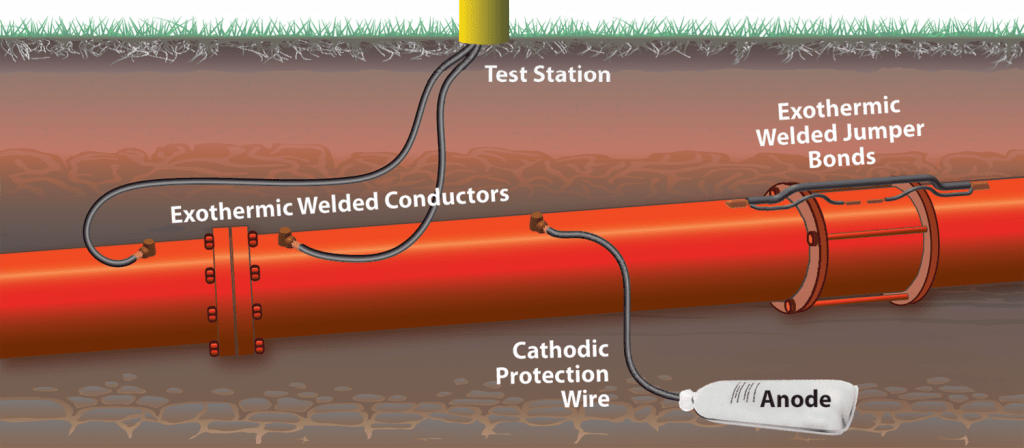
Chemical protection
Chemical protection includes corrosion inhibitors, Oxygen purification system, and biocide in a chemical process.
In the chemical process, biocide is injected into the system, liquid or water to kill microorganisms such as reduced bacteria that increase corrosion under microbiological effects with sulfide. Oxygen scavenging chemicals are injected into the water to deoxygenate to reduce the severity of the corrosion and ultimately achieve adequate cathodic protection of the pipelines.
- Published in Articles, Educational, Scientific
What is the cathodic protection?
Cathodic protection and its different types
Cathodic protection is a way to reduce corrosion by minimizing the potential difference between the anode and the cathode. This is achieved by creating a stream from an external source on the structure to be protected (such as a pipeline). When enough current is used, the whole structure will be at a potential. Therefore, there will be no anode and cathode sites. Cathodic protection is commonly used to protect numerous structures against corrosion, such as ships, sea vessels, submarine equipment, ports, pipelines, and tanks.
Types of cathodic protection systems
There are two main types of cathodic protection systems: galvanic system and impressed current system. Note that both types include an anode (from which current flows into the electrolyte), a continuous electrolyte from the anode to the protected structure, and an external metal connection.
• Galvanic system:
Galvanic cathodic protection system uses corrosion potentials for various metals. Without cathodic protection, there is one area of the structure with more negative potential than other areas and corrosion occurs. In this case, if an object with a higher negative potential (such as a magnesium anode) is protected near the structure (such as a pipeline) and a metal connection is made, the object becomes an anode and the whole structure becomes a cathode.
Therefore, the galvanic cathode protection system is called a sacrificial anode cathode protection system because the anode is sacrificed to protect the structure. Sacrificial anodes are usually made of metals such as magnesium, zinc and aluminum.
•Impressed current system
Impressed current cathodic protection system is a type of system that is usually applied in cases where there is a high flow requirements to protect against corrosion. The main difference between impressed current systems and sacrificial anodes is that the sacrificial anode system relies on the potential difference between the anode and the structure, while the impressed current system uses an external energy source to conduct the current. Impressed current anodes are usually high silicon cast iron anodes or mixed metal oxide anodes.
- Published in Articles, Educational, Scientific


